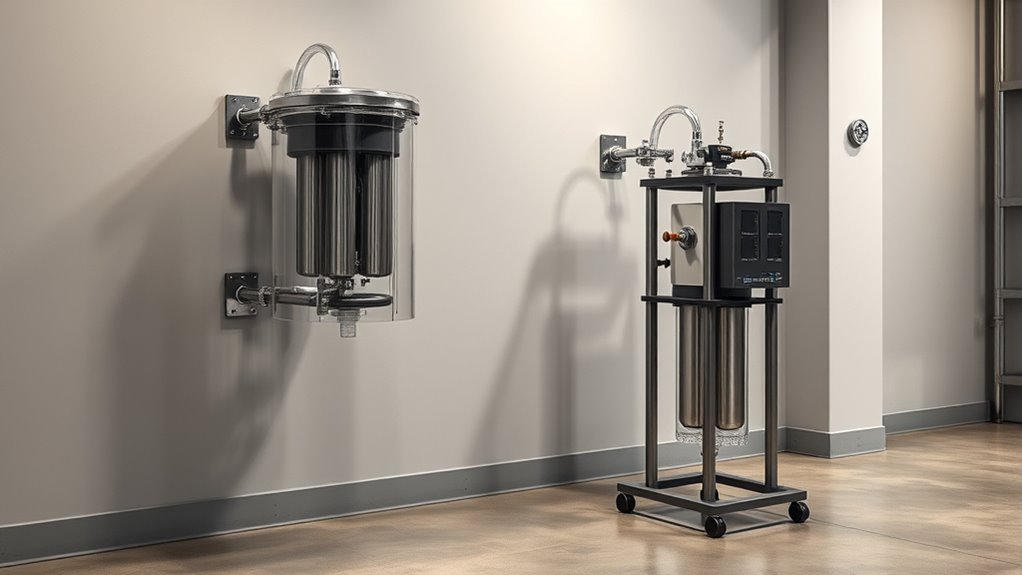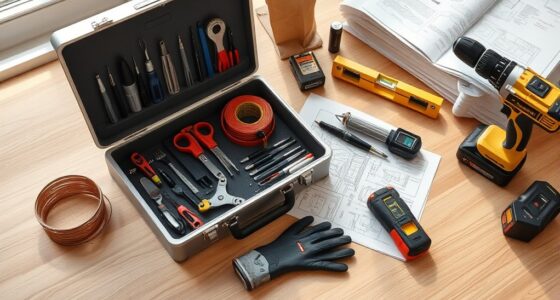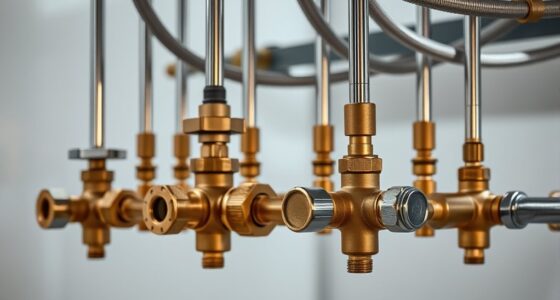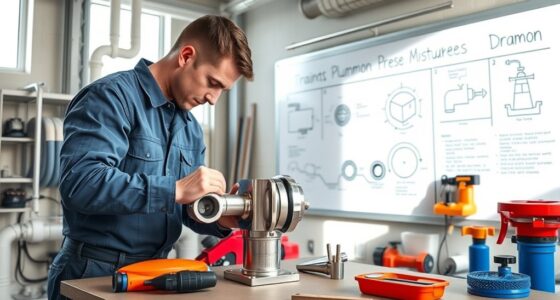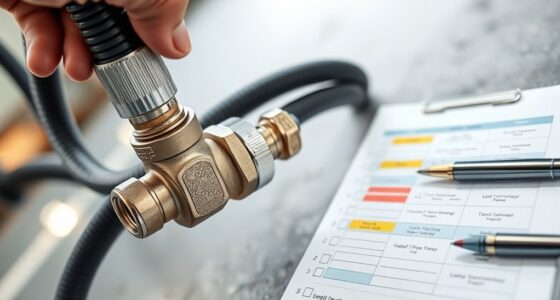When mounting filter housings securely, consider space constraints and accessibility. Wall mounting saves space and keeps units at a comfortable height, but make certain brackets are rated for the weight and anchored into studs for stability. Floor mounting provides a stable base, especially for heavier units, but requires enough room for maintenance. Both options require proper hardware and installation to prevent accidents. Keep exploring to discover tips that help you choose the best method for your setup.
Key Takeaways
- Ensure wall brackets are rated for the housing’s weight and anchored into studs or solid anchors for stability.
- Use a level and sturdy, level surface when floor mounting to prevent wobbling or tipping.
- Consider space constraints; wall mounting saves space, while floor mounting offers easier access for maintenance.
- Verify wall strength and proper anchoring to prevent dislodgement or damage.
- Secure all mounting hardware tightly to meet safety standards and prevent accidental dislodging.
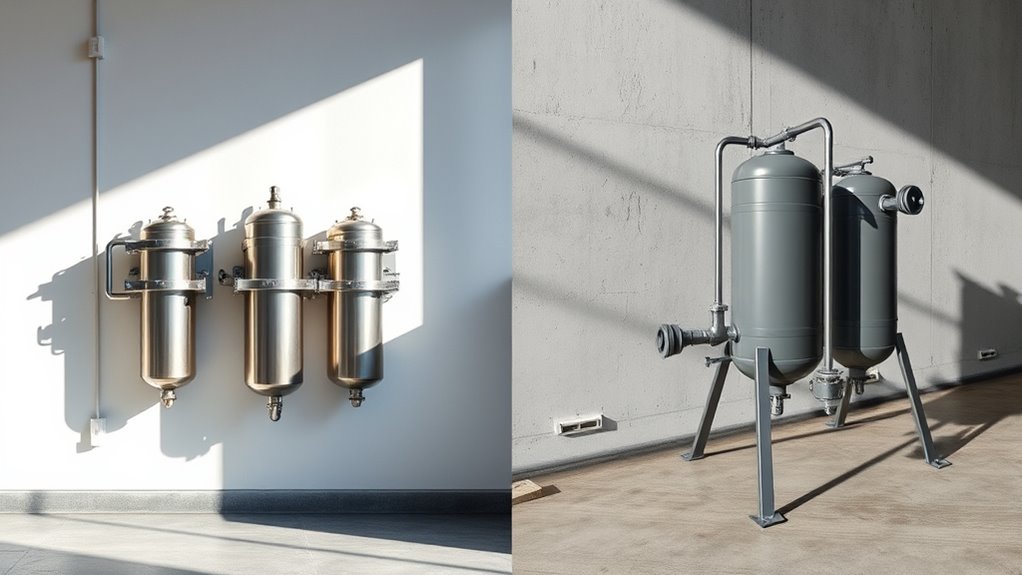
Mounting filter housings correctly is vital for guaranteeing your filtration system operates efficiently and safely. When deciding whether to mount your filter housings on the wall or on the floor, you need to take into account several factors, especially installation considerations and maintenance accessibility. Your choice impacts not only the stability of the system but also how easily you can perform routine maintenance or address issues down the line.
Wall mounting offers a compact and space-saving option, which is ideal if you have limited room. When installing on a wall, you should check that the wall can support the weight of the filter housing, especially when it’s filled with water or other liquids. Properly anchoring the brackets is essential; using the right wall anchors or screws for your wall type ensures stability. Also, consider the height at which you mount the housing. Positioning it at a comfortable level makes maintenance tasks, like replacing filters or checking for leaks, much easier and more accessible. This improves maintenance accessibility, reducing the risk of strain or injury during routine upkeep.
Floor mounting, on the other hand, provides a more stable platform, especially for larger or heavier filter housings. You’ll want to verify that the floor is level and sturdy enough to support the weight, preventing any wobbling or accidental tipping. Floor mounting can be advantageous if space is ample, giving you easier access from all sides. It also simplifies installation since you don’t have to worry about wall strength or the need for specialized mounting hardware. Additionally, floor-mounted housings are typically easier to access for maintenance, as you can walk around them freely, making filter replacements and inspections straightforward.
Whichever mounting option you choose, you need to think about safety and compliance. Secure mounting prevents accidental dislodging, which could lead to water damage or system failure. For wall mounting, ensure that the brackets are rated for the weight of your specific housing and that they are installed into studs or appropriate anchors. For floor mounting, consider using a mounting stand or a secure base to prevent slipping or movement.
Frequently Asked Questions
What Are the Cost Differences Between Wall and Floor Mounting?
The cost differences between wall and floor mounting mainly involve installation flexibility and aesthetic integration. Wall mounting often costs less upfront because it’s simpler and quicker to install, saving you labor expenses. Floor mounting may have higher initial costs due to additional support structures but offers greater stability and versatility. Consider your space and aesthetic goals; wall mounting provides a cleaner look, while floor mounting can be more adaptable for larger, heavy housings.
How Does Mounting Location Affect Maintenance Access?
Imagine a tiny misstep turning maintenance into a wild adventure! When you mount filter housings on the wall, you’ll enjoy unmatched ease of access, making repairs feel like a breeze. Floor mounting, however, can turn into a complex maze during installation, with harder access and potential for more hassle. Your choice directly impacts maintenance ease of access and installation complexity, so pick wisely to save time and frustration later.
Are There Specific Safety Considerations for Each Mounting Type?
You should consider safety standards and installation hazards when choosing between wall or floor mounting. Wall mounting reduces trip hazards and allows easier access, but guarantee secure brackets to prevent falls. Floor-mounted housings offer stability but pose risks of accidental bumps or spills. Always follow safety standards, use proper tools, and inspect mounts regularly to prevent accidents and ensure safe operation, regardless of your chosen mounting type.
Can Mounting Options Impact Filter Housing Lifespan?
Your mounting options can impact filter housing lifespan by affecting installation stability and vibration effects. If you choose a stable wall or floor mount, it minimizes movement and reduces wear over time. Floor mounts might be more vulnerable to vibrations from machinery, potentially causing wear on connections or seals. Properly securing your housing, regardless of the mounting type, helps extend its lifespan by preventing unnecessary stress and damage.
Which Mounting Method Is More Suitable for Outdoor Environments?
Think of outdoor environments as a battleground—your filter housing must stand strong. Wall mounting is more suitable because it offers better weather resistance and vandalism prevention. By elevating the unit, you reduce exposure to moisture, dirt, and tampering. This setup helps prolong your filter housing’s lifespan, ensuring it stays protected and performs effectively despite harsh weather or potential vandalism threats.
Conclusion
Whether you choose wall or floor mounting, securing your filter housing is like planting a sturdy tree—firm and reliable. Wall mounts keep your setup neat as a row of soldiers, while floor mounts stand tall like guardians of your water quality. Whichever you pick, make sure it’s anchored well, so your system flows smoothly without a wobble. Think of it as giving your filtration fortress a solid foundation—ready to stand strong through every drop.
